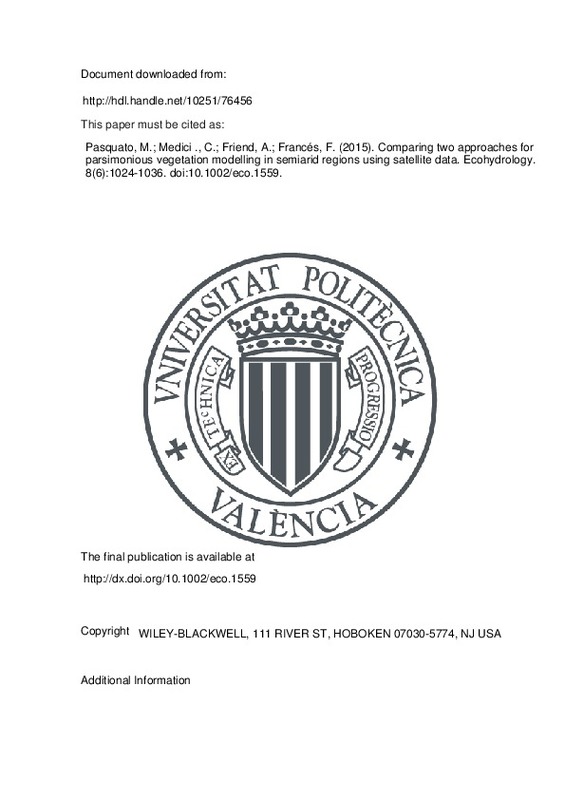JavaScript is disabled for your browser. Some features of this site may not work without it.
Buscar en RiuNet
Listar
Mi cuenta
Estadísticas
Ayuda RiuNet
Admin. UPV
Comparing two approaches for parsimonious vegetation modelling in semiarid regions using satellite data
Mostrar el registro sencillo del ítem
Ficheros en el ítem
| dc.contributor.author | Pasquato, Marta
|
es_ES |
| dc.contributor.author | Medici, Chiara
|
es_ES |
| dc.contributor.author | Friend, A.D.
|
es_ES |
| dc.contributor.author | Francés, F.
|
es_ES |
| dc.date.accessioned | 2017-01-09T11:59:24Z | |
| dc.date.available | 2017-01-09T11:59:24Z | |
| dc.date.issued | 2015-09 | |
| dc.identifier.issn | 1936-0584 | |
| dc.identifier.uri | http://hdl.handle.net/10251/76456 | |
| dc.description.abstract | [EN] Large portions of Earth's terrestrial surface are arid or semiarid. As in these regions, the hydrological cycle and the vegetation dynamics are tightly interconnected, a coupled modelling of these two systems is needed to fully reproduce the ecosystem behaviour. In this paper, the performance of two parsimonious dynamic vegetation models, suitable for the inclusion in operational ecohydrological models and based on well-established but different approaches, is compared in a semiarid Aleppo Pine region. The first model [water use efficiency (WUE) model] links growth to transpiration through WUE; the second model [light use efficiency (LUE) model] simulates biomass increase in relation to absorbed photosynthetically active radiation and LUE. Furthermore, an analysis of the information contained in MODIS products is presented to indicate the best vegetation indices to be used as observational verification for the models. Enhanced Vegetation Index is reported in literature to be highly correlated with leaf area index, so it is compared with modelled LAI(mod) (rWUE model = 0.45; rLUE model = 0.57). In contrast, Normalized Difference Vegetation Index appears highly linked to soil moisture, through the control exerted by this variable on chlorophyll production, and is therefore used to analyze LAI*(mod), models' output corrected by plant water stress (rWUE model = 0.62; rLUE model = 0.59). Moderate-resolution imaging spectroradiometer Leaf Area Index and evapotranspiration are found to be unrealistic in the studied area. The performance of both models in this semiarid region is found to be reasonable. However, the LUE model presents the advantages of a better performance, the possibility to be used in a wider range of climates and to have been extensively tested in literature. (C) Copyright 2014 John Wiley & Sons, Ltd. | es_ES |
| dc.description.sponsorship | The research leading to these results has received funding from the Spanish Ministry of Economy and Competitiveness through the research projects FLOOD-MED (ref. CGL2008-06474-C02-02), SCARCE-CONSOLIDER (ref. CSD2009-00065) and ECO-TETIS (ref. CGL2011-28776-C02-01), and from the European Community's Seventh Framework Programme (FP7 2007-2013) under grant agreement no. 238366. The MODIS data were obtained through the online Data Pool at the NASA Land Processes Distributed Active Archive Centre (LP DAAC), USGS/Earth Resources Observation and Science (EROS) Centre, Sioux Falls, South Dakota (https://lpdaac.usgs.gov/get_data). The meteorological data were provided by the Spanish National Weather Agency (AEMET). The authors thank Antonio Del Campo Garcia and Maria Gonzalez Sanchis at the Universitat Politecnica de Valencia for their support and valuable comments. | en_EN |
| dc.language | Inglés | es_ES |
| dc.publisher | WILEY-BLACKWELL, 111 RIVER ST, HOBOKEN 07030-5774, NJ USA | es_ES |
| dc.relation | MINECO/CSD2009-00065 | es_ES |
| dc.relation.ispartof | Ecohydrology | es_ES |
| dc.rights | Reserva de todos los derechos | es_ES |
| dc.subject | Vegetation | es_ES |
| dc.subject | Modelling | es_ES |
| dc.subject | Satelite | es_ES |
| dc.subject | Semiarid | es_ES |
| dc.subject.classification | INGENIERIA HIDRAULICA | es_ES |
| dc.title | Comparing two approaches for parsimonious vegetation modelling in semiarid regions using satellite data | es_ES |
| dc.type | Artículo | es_ES |
| dc.identifier.doi | 10.1002/eco.1559 | |
| dc.relation.projectID | info:eu-repo/grantAgreement/EC/FP7/238366/EU/Anticipating climate change and biospheric feedbacks within the Earth system to 2200/ | es_ES |
| dc.relation.projectID | info:eu-repo/grantAgreement/MICINN//CGL2008-06474-C02-02/ES/SIMULACION Y ANALISIS DE FRECUENCIA DE LAS CRECIDAS CON ESCENARIOS DE CAMBIOS CLIMATICO Y MEDIOAMBIENTALES EN CUENCAS MEDITERRANEAS/ | es_ES |
| dc.relation.projectID | info:eu-repo/grantAgreement/MICINN//CGL2011-28776-C02-01/ES/MODELACION ECOHIDROLOGICA DISTRIBUIDA A ESCALA DE CUENCA PARA BOSQUES EN CLIMAS SEMIARIDOS/ | es_ES |
| dc.rights.accessRights | Abierto | es_ES |
| dc.contributor.affiliation | Universitat Politècnica de València. Escuela Técnica Superior de Ingenieros de Caminos, Canales y Puertos - Escola Tècnica Superior d'Enginyers de Camins, Canals i Ports | es_ES |
| dc.contributor.affiliation | Universitat Politècnica de València. Instituto Universitario de Ingeniería del Agua y del Medio Ambiente - Institut Universitari d'Enginyeria de l'Aigua i Medi Ambient | es_ES |
| dc.description.bibliographicCitation | Pasquato, M.; Medici, C.; Friend, A.; Francés, F. (2015). Comparing two approaches for parsimonious vegetation modelling in semiarid regions using satellite data. Ecohydrology. 8(6):1024-1036. https://doi.org/10.1002/eco.1559 | es_ES |
| dc.description.accrualMethod | S | es_ES |
| dc.relation.publisherversion | http://dx.doi.org/10.1002/eco.1559 | es_ES |
| dc.description.upvformatpinicio | 1024 | es_ES |
| dc.description.upvformatpfin | 1036 | es_ES |
| dc.type.version | info:eu-repo/semantics/publishedVersion | es_ES |
| dc.description.volume | 8 | es_ES |
| dc.description.issue | 6 | es_ES |
| dc.relation.senia | 307652 | es_ES |
| dc.contributor.funder | European Commission | |
| dc.contributor.funder | Ministerio de Ciencia e Innovación | es_ES |







![[Cerrado]](/themes/UPV/images/candado.png)

